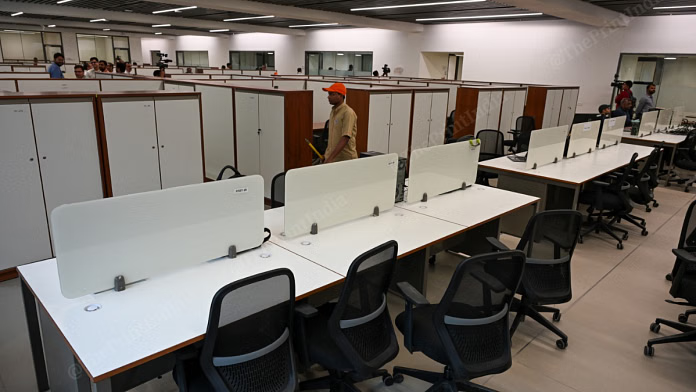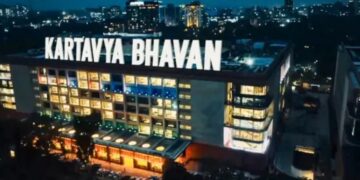Ahead of the PM’s inauguration, Kartavya Bhavan’s space crunch sparks concerns over confidentiality and secure government operations.

Cramped Kartavya Bhavan Sparks Confidentiality Concerns Ahead of PM Inauguration
As Prime Minister Narendra Modi prepares to inaugurate Kartavya Bhavan on August 6, 2025, officers of the Central Secretariat Service (CSS) have raised alarm over the building’s cramped workspace design, warning it compromises confidentiality and undermines efficiency.
In a strongly worded letter addressed to the Prime Minister’s Office and the Ministry of Housing & Urban Affairs on August 5, 2025, CSS officials voiced frustration over the lack of enclosed, private spaces for handling sensitive work. They emphasised that the current layout fails to provide adequate “spatial integrity” and functional separation among departments—a sharp departure from historical norms.
From Individual Chambers to Open-Plan Clusters
Traditionally, even section officers and assistant section officers (ASOs/SOs) in older Secretariat buildings were allocated shared rooms, while higher-ranking officials like under-secretaries and deputy secretaries had their own enclosed offices. By contrast, CSS employees now find themselves in an open‑plan configuration, where even under-secretaries are in shared rooms without partitions.
Workstations for Group A officers—those entrusted with handling classified files, court litigation, vigilance cases, commercial bids, and high‑level correspondences—are now situated in open office zones. The officials argue this setup allows others to overhear telephonic and face‑to‑face discussions, thereby exposing classified matters to potential breaches.
Demoralisation, Distraction, Distrust
CSS officers describe the current layout as demoralising and detrimental to both focus and critical thinking. They contend that relying on such open configurations runs counter to the stated goal of empowering officers with “adequate and modernised working environments”, as envisioned by the Prime Minister.
A collective sense of inequality has also emerged. IAS officers serving at equivalent ranks—such as deputy secretaries and directors—have reportedly been allotted individual rooms, in stark contrast to their CSS peers. This disparity in space entitlement is viewed as “arbitrary and discriminatory”.
Calls for Immediate Intervention
In their letter, CSS officers urged authorities to enforce office-space norms prescribed by the Ministry of Urban Development. They demanded:
- Closed chambers for all Group A CSS officers (under‑secretaries and above).
- Adequate enclosed seating for sections dealing with confidential matters, including ASOs and SOs.
- Uniformity in office allocation to ensure parity in status and access.
They warned that without such measures, Kartavya Bhavan could fail in its purpose from the outset—despite being designed to last for decades.
Kartavya Bhavan: A Green Complex—but Flawed in Design?
Kartavya Bhavan is the flagship of the first wave of Common Central Secretariat (CCS‑3) buildings under the Central Vista Project. Spanning an estimated 1.5 lakh square metres, it is slated to house key ministries including Home Affairs, External Affairs, MSME, Petroleum & Natural Gas, among others.
Promoted as a state‑of‑the‑art, zero‑discharge green building, it includes energy-efficient features—double‑glazed windows, sensor‑controlled LED lighting, rooftop solar PV systems generating over 5.34 lakh units annually, solar water heating, rainwater harvesting, in-house solid‑waste composting, and EV charging stations for up to 650 vehicles daily.
This six‑storey complex, targeting a GRIHA 4‑star rating, integrates modern infrastructure to streamline governance and improve inter‑ministerial coordination. It replaces aging labour‑intensive buildings like Shastri Bhavan, now considered structurally and operationally outdated.
An Infrastructure of Ideals, But Missing the Human Element
While designers have prioritized eco‑credentials and technological excellence, critics highlight a glaring oversight: the human element of governance.
CSS officers argue substantial thought was poured into sustainable systems, but none into ensuring that high‑sensitivity bureaucrats have privacy. This, to them, is not just an ergonomic flaw but a fundamental operational risk.
What’s Next? A Resolve or Retrofitting?
With inauguration scheduled for August 6, 2025 at 12:15 pm, followed by a public programme at Kartavya Path in the evening, attention now turns to whether the government will respond to these grievances.
Photos of the building’s interior remain scarce, but if current reports are accurate, serious retrofitting or policy adjustments may be required post‑inauguration.
The CSS officers highlight one iron-clad principle: Wherever sensitive, classified, or high‑stake tasks are handled, privacy isn’t optional—it’s essential. With Kartavya Bhavan’s cutting-edge image on display, the question remains whether behind the glass façade, robust human‑centric governance can stand up to first day scrutiny—or crumble under its own constraints.
Although Kartavya Bhavan represents a major leap forward in infrastructure and sustainability for India’s administrative architecture, CSS officers fear its design compromises essential confidentiality and work ethics. They have formally urged the PMO and Urban Affairs Ministry to intervene, citing disparity, demotivation, and serious risk of breach of sensitive information. Whether their demands will shape immediate corrections—or longer-term retrofits—will unfold in the days following the building’s grand unveiling.
READ ALSO…..Ahaan Panday, Bollywood’s ₹500 Crore Rising Star, Wins Hearts While Strolling Alone in Mumbai















 Categories
Categories









